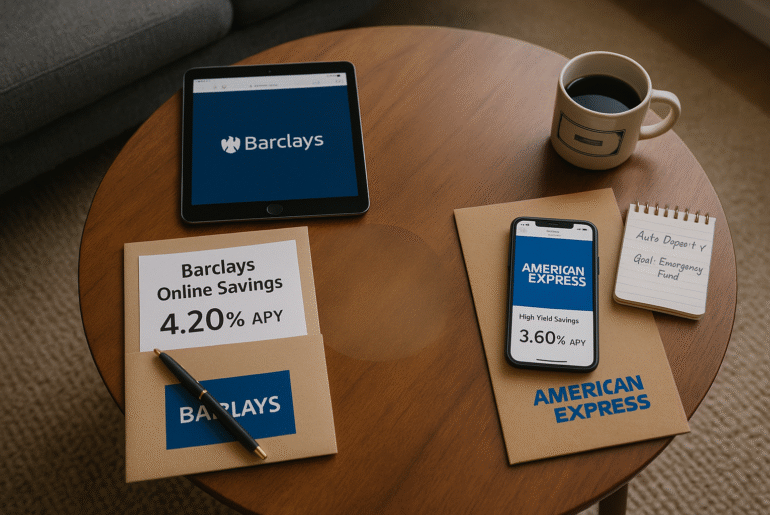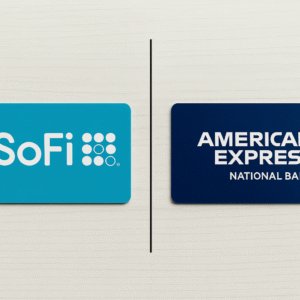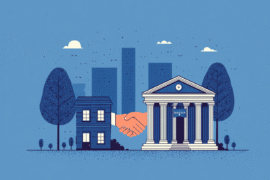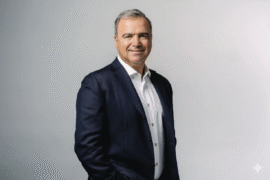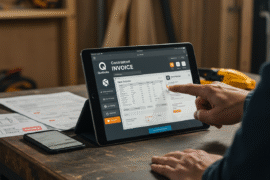This article may contain references to products or services from one or more of our advertisers or partners. We may receive compensation when you click on links to those products or services. Nonetheless, our opinions are our own.
The information presented in this article is accurate to the best of our knowledge at the time of publication. However, information is subject to change, and no guarantees are made about the continued accuracy or completeness of this content after its publication date.
Barclays vs American Express for Savings
- See how Barclays Bank and American Express National Bank stack up side by side, so you can pick the best high-yield savings account for your money needs.
- Check out each bank’s interest rates, APY, and what makes each one stand out so you can spot the most appealing offers.
- Learn how their online banking systems and customer service shape the full banking experience.
- Look at important things like minimum deposit, fees, and account tools to make sure there are no surprises.
- Find out which bank helps you more with your savings goals by using simple tools and helpful resources.
- Pick with ease to help grow your savings and to match what you like when it comes to your money.
Introduction
Are you trying to decide between Barclays Bank and American Express National Bank? Picking the best savings option can really affect your money goals. These two banks both give you the chance to open a good high-yield savings account. But it is not always an easy choice to make. Things like how they treat people, how much money you need to start, and the online tools they give you can make a big difference. No matter if you are taking care of a checking account or you want your money to grow fast in a high-yield option, this breakdown gives you a way to see what each has. That way, you can find the one that works for you.
| Feature | Barclays Bank | American Express National Bank |
|---|---|---|
| APY (High Yield Savings) | Up to 4.20% (Tiered, depending on balance) | 3.60% (Flat rate) |
| CD Rates (12–60 months) | 3.00%–4.00% | 3.50% – 4.00% |
| Minimum Deposit | $0.01 | $0 |
| Monthly Maintenance Fees | None | None |
| Account Types | Tiered Savings, CDs | High-Yield Savings, CDs |
| ATM Access | No | No |
| Physical Branches | No (Online Only) | No (Online Only) |
| Mobile Check Deposit | Yes | Yes |
| Customer Support | Online and phone support | 24/7 customer support |
| Digital Tools | Savings Assistant | Tips & Tools, Auto-Deposit |
| FDIC Insured | Yes, up to $250,000 | Yes, up to $250,000 |
Voted "Best Overall Budgeting App" by Forbes and WSJ
Monarch Money helps you budget, track spending, set goals, and plan your financial future—all in one app.
Get 50% OFF your first year with code MONARCHVIP
How to Choose Between Barclays and American Express
Factors to Consider When Choosing Between These Banks
There are several things you need to think about when you choose between Barclays and American Express for your savings. First, be clear about what you want to do with your savings, as this will help you make better choices. Look at things like how much money you have to put in to open the account, what the interest rates are, and if there are any fees each month that could affect how much you save. You should also check the online banking options. These include how good the mobile apps are and what digital tools there are for handling your money, so your banking is easy. Take a look at how you can reach customer help too, because getting good support can really help when you need to manage your accounts well.
Requirements to Open a Savings Account
To open a savings account at Barclays or American Express, you will need some things to get started. You have to show who you are. You can do this with your government ID and your Social Security number. You will also need to think about how much money to put in at first. These banks ask for a minimum deposit for your first money in the account.
If you want to use online banking, you will need to make sure you have the internet. You can use a web browser or an app to get in. You also need to give your data so the bank can check you and keep your account safe.
At the end, read each bank’s rules to learn more about every fee and feature in the account. This way, you get to know what is best for you.
How to Pick the Right Savings Account
To pick the right savings account, you need to go step by step. First, think about what you want to save for. Knowing your savings goals will help you make the best choice. Then, look at the interest rates and APY from many banks, like high-yield savings accounts from Barclays and American Express. You should also look at things like how much money you need to open the account and any fees that may come up. At the end, check out the online banking features and how you can talk to customer support. Make sure these things work well for you and help you to manage your money easily.
Final Thoughts
Choosing between Barclays and American Express for your savings is about your own needs and what you want. Both banks have good things to offer, like good APYs and different types of accounts that can help you save. You should look at things like interest rates, fees, and how easy it is to use their online banking. This will help you pick what works best for you. Good saving begins when you know what each bank can give you. This way, you can make better choices with your money over time.
Frequently Asked Questions
Are my deposits safe with barclays and american express?
Both barclays and american express have strong security steps. Your deposits in these banks are protected by fdic insurance up to $250,000. They use good encryption and watch over accounts with care. This helps keep your savings safe in both places.
Can I open an account online with both banks?
Yes, you can open a new account online with both barclays and american express. Their websites help you get started in an easy way. You will only need to go to their application pages and sign up from your home. Make sure you have your documents ready to keep the process smooth and quick.
What are the minimum deposit requirements?
Both barclays and american express have different rules for the lowest amount you need to put in when you open their savings accounts. Usually, barclays will ask for at least $100 to start, but american express can let you begin with just $1. You should check these rules before you open an account.
How often do interest rates change for these savings accounts?
Interest rates for savings accounts can go up or down often. The reason for this is the way the market and central bank rules keep changing. Most banks check their rates each month or every few months. But there are times when rates can change at any time because of big changes in the economy or what other banks are doing.

Reviewed and edited by Albert Fang.
See a typo or want to suggest an edit/revision to the content? Use the contact us form to provide feedback.
At FangWallet, we value editorial integrity and open collaboration in curating quality content for readers to enjoy. Much appreciated for the assist.
Did you like our article and find it insightful? We encourage sharing the article link with family and friends to benefit as well - better yet, sharing on social media. Thank you for the support! 🍉
Article Title: Barclays vs. Amex Savings: Which Bank Offers Better Returns?
https://fangwallet.com/2025/07/09/barclays-vs-amex-savings-which-bank-offers-better-returns/The FangWallet Promise
FangWallet is an editorially independent resource - founded on breaking down challenging financial concepts for anyone to understand since 2014. While we adhere to editorial integrity, note that this post may contain references to products from our partners.
The FangWallet promise is always to have your best interest in mind and be transparent and honest about the financial picture.
Become an Insider

Subscribe to get a free daily budget planner printable to help get your money on track!
Make passive money the right way. No spam.
Editorial Disclaimer: The editorial content on this page is not provided by any of the companies mentioned. The opinions expressed here are the author's alone.
The content of this website is for informational purposes only and does not represent investment advice, or an offer or solicitation to buy or sell any security, investment, or product. Investors are encouraged to do their own due diligence, and, if necessary, consult professional advising before making any investment decisions. Investing involves a high degree of risk, and financial losses may occur including the potential loss of principal.
Source Citation References:
+ Inspo
There are no additional citations or references to note for this article at this time.
